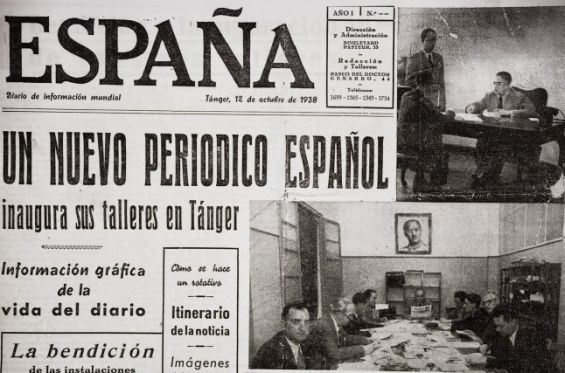Located a few miles south of the Strait of Gibraltar, Tetouan was the first Moroccan city to witness the appearance of a newspaper. Amid the 19th century, journalism made its way to the North African Kingdom through Spain, an enemy nation that sent its troops to fight the Spanish-Moroccan War.
Historical accounts agree that El Eco de Tetuan was the first Spanish-language publication to be printed and sold in Northern Morocco. The idea was initiated by Spanish writer and journalist Pedro Antonio de Altonio de Alarcon who in 1859 joined a Spanish military operation in Morocco. It was the same year that the Spaniards decided to fight La Guerra de África which mostly took place in Tetouan.
El Eco de Tetuan and the Spanish army
In an article published by El Rincon de Sidi Ifni, a platform focused on the Spanish-Moroccan shared history, El Eco de Tetuan appeared in March 1860 in an attempt for Alarcon to keep a record of his journey in Morocco and do the job he lived for.
Unfortunately, El Eco de Tetuan had only one issue before disappearing later. It was the first newspaper to be printed in the Kingdom with the help of the Spanish military printery.

The same trend continued giving birth to El Noticiero de Tetuán. The latter was founded by two soldiers from the Spanish army deployed in the city during the Tetouan War. «On its cover, it was stated that it would have an issue appearing every two or three days», wrote El Rincon de Sidi Ifni. The newspaper had four pages, due to paper shortage, and was a non-professional military publication.
«El Noticiero de Tetuán produced 89 issues and was targeting militants in general», explains the same source. Its slogan was «A Newspaper on Spain’s Interests in Africa», and was believed to be the first Spanish newspaper to show interest in the continent.
In 1861, El Noticiero stopped appearing since the war ended and one of the clauses in the Wad-Ras Treaty forced the Spanish army and its press to withdraw.
Other historical accounts, however, suggest that El Noticiero de Tetuan was only an extension of El Eco de Tetuan. Celebrating the 150th anniversary of the newspaper, Granada Hoy wrote in an article, that the two newspapers were a way for Spanish soldiers to fight using words, when realizing that a writing machine is stronger than all the weapons they had.
«The newspaper was run by Spanish soldiers who worked with their military uniforms on and rifles next to them», said the platform.
This was confirmed by Pedro Antonio de Altonio de Alarcon who stated on the very first day of his newspaper’s foundation : «I want them to say that in 1860 a Spanish Army was here… it printed a newspaper in Tetouan bearing ideas and values».
Local newspapers in Northern Morocco
In 1880, the major European nations and the United States decided to preserve the territorial integrity of Morocco and to maintain equal trade opportunities for all. This objective was at the heart of an agreement signed in Madrid during the same year.
The meeting hosted by Spain was also an opportunity to discuss journalism in the Kingdom and how the clauses agreed on can be circulated through the press. For El Rincon de Sidi Ifni, the conference paved the way for the creation of Al-Moghreb Al Aksa. The latter «appeared on January 28th, 1883 as a weekly newspaper consisting of four pages».
It was mainly financed by the Spanish Delegation in Tangier and published local and international reports with focused interests. On the same year, Tanger Gazette, a Spanish-language English newspaper, was created.

The trend then spread, and other publications emerged such as satirical weekly The African in 1885, Tangier-based newspaper El Eco Mauritano in 1886, and monthly newspaper La duda del progreso marroqui in 1888.
Eco de Tetuan made its return, in 1911, following the request of a Spanish diplomat. The newspaper bore the same mission set the first day by its founder, Alarcon, publishing until 1929. Other newspapers commenced their operations later as the Civil War in Spain took place, targeting small cities in the northern region of the country.
Zamane made reference to Rincon, founded in 1917, Predictor (1952), El Hoyo in Oued Laou (1953), Atkaten (1947) and La Voz de mi Escuela (1949) in Segangan, La Campana (1947) in Snada, El Eco de Laucien (1913) and El Tanquista in Lauzien.
The city of Larache has seen the creation of more than 25 publications, including 6 dailies: Hispania, which is Larache's first newspaper (1914), La Correspondencia de Africa (1915), El Popular (1916), Diario Marroqui (1920), Heraldo de Marruecos (1923) and Diario de Larache (1946).
Fighting propaganda
Years after the Spanish initiative, French-language newspapers emerged under the French protectorate, starting from 1920. L’Echo du Maroc and La Vigie Marocaine started to appear and the creation of the MAS press group allowed the appearance of Farmhouse and Le petit marocain.
To fight back ideas conveyed by these newspapers, serving most of the time the French and Spanish propaganda, Moroccan nationalists issued their own publications. Spreading ideas about independence, figures such as Mohamed Bennouna and Mohamed Al Ouazzani created platforms in Arabic such as Al Salam, Al Hayat alongside French-language weekly L’action du Peuple.





 chargement...
chargement...













